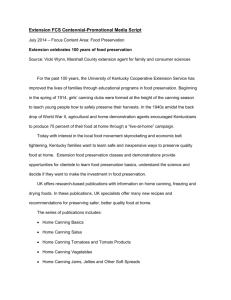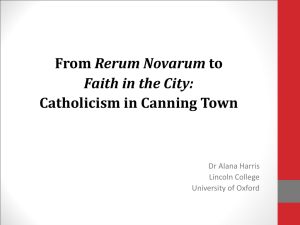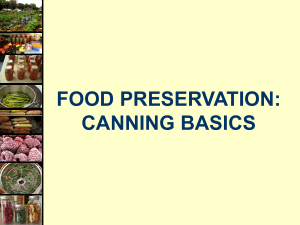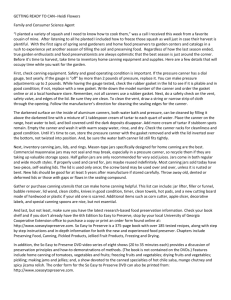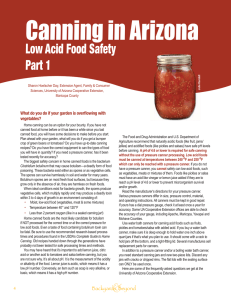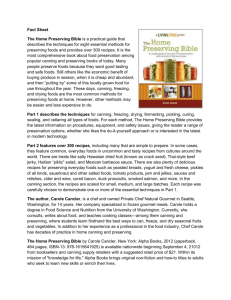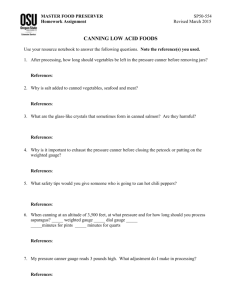Modern Methods of Home Food Preservation
advertisement
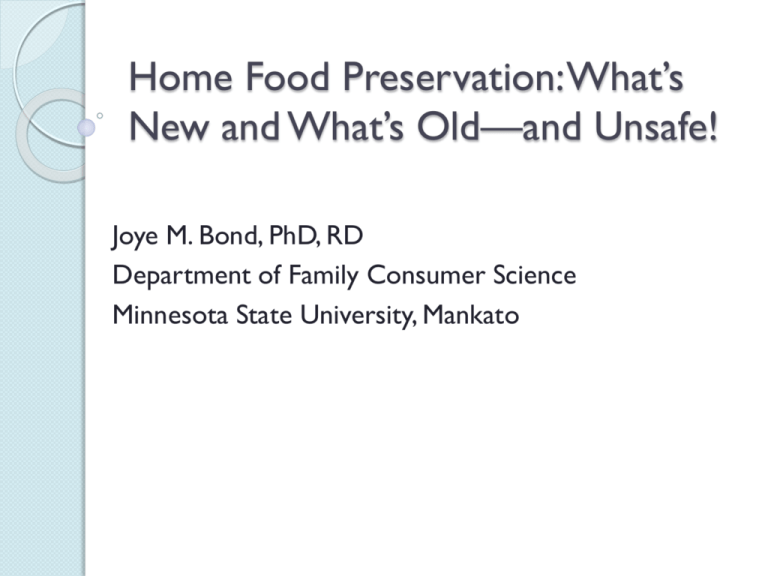
Home Food Preservation: What’s New and What’s Old—and Unsafe! Joye M. Bond, PhD, RD Department of Family Consumer Science Minnesota State University, Mankato Food Preservation Methods Canning Freezing Drying Pickling Sugar concentrates ◦ Jams, jellies, butters, preserves, etc. History of USDA Publications 1909—Canning Vegetables in the Home WWI—Can the Kaiser WWII—Victory Gardens Early 1950s—USDA research switched to freezing Complete Guide to Home Freezing was drafted in 1980s, but never published Majority of today’s processes are based on USDA research from 1944-46 Some limited research by various universities after USDA stopped 1980s—USDA/Penn State Center of Excellence ◦ ◦ ◦ ◦ ◦ Conducted extensive literature review Evaluated tomato processes Fruit pie fillings National training for Extension faculty Published Complete Guide to Home Canning in 1988 (revised in 1989, 1994, 2009) National Center for Home Food Processing and Preservation University of Georgia—lead institution ◦ Literature review ◦ Updating of USDA/Extension publications ◦ New website: National Center for Home Food Preservation ◦ Instructional video series ◦ Web-based curriculum on home food preservation ◦ Original applied research Applied Research Microbial issues of herbs and spices used in home food preparation of flavored vinegars, salsas, & oils Canning fruit with Splenda® Development of “specialty” foods—salsas, sugar concentrates, relishes, sauces, and marinades Why Preserve at Home? Save food from a “time of plenty” to a “time of need” Prevent spoilage until food can be eaten Know what is in the food Personal satisfaction How Methods Preserve Food Refrigeration ◦ Extends shelf-life by slowing growth of microorganisms and action of enzymes Freezing ◦ Lowered temperature lowers the available water (Aw) How Methods Preserve Food Canning fruits and tomatoes ◦ ◦ ◦ ◦ Removal of O2 Sealed jar Heat (boiling water processed) Acidity (natural or added) Canning vegetables and meats ◦ Removal of O2 ◦ Sealed jar ◦ Heat (pressure processed) How Methods Preserve Food Sweetening & Acidifying (jams, jellies, spreads) ◦ ◦ ◦ ◦ ◦ Lower (Aw) Removal of O2 Sealed jar Heat (boiling water processed) Acidity of the fruit How Methods Preserve Food Pickling & Fermenting ◦ ◦ ◦ ◦ Increased acidity—added or created Heat (boiling water processed) Removal of O2 Sealed jar How Methods Preserve Food Drying ◦ Lower (Aw) Home canning is back! And botulism still does occur… ◦ July 2012—Oregon, home-canned foods served at a barbecue ◦ 2008, 2009—Ohio and Washington, green beans Basics of Home Canning Food in a jar is heated to a temperature that kills microorganisms Heat also inactivates enzymes that cause food spoilage With jars, air is driven from the jars with heating; as jar cools, a vacuum seal is created Vacuum Seal Holds lid on jar Prevents recontamination of food Prevents air from drying out food Two Methods of Canning Boiling Water Canning ◦ Used for acid foods Pressure Canning ◦ Used for low acid foods (and some acid foods) Acid Foods pH≤4.6 Most fruits (some exceptions, e.g., melons) Tomatoes are borderline—specific amounts of citric acid or lemon juice must be added before canning to acidify) Sauerkraut pH of Some Common Foods Acidified Foods pH≤4.6 Mixtures of acid and low acid foods with an equilibrium pH≤4.6 Low Acid Foods pH>4.6 Most vegetables Meats, poultry, seafood Soups Mixtures of acid and low acid foods (e.g., spaghetti sauce—meat, vegetables, tomatoes; salsa—tomatoes, onions, peppers) Why Two Methods? Clostridium botulinum Yeast, molds, and most bacteria killed fairly easily at boiling temperatures (212˚F at sea level) C. botulinum forms spores that require a higher temperature for destruction in a reasonable amount of time (usually 240˚F at sea level) Preventing Botulism Spores won’t germinate in acid foods Spores killed when heated long enough at a specific temperature USDA usually recommends 240˚F at sea level Pressure canner must be used for all low acid foods Preventing Botulism Proper preparation and process time Canner must be accurate and operated correctly Altitude adjustments need to made as needed Use directions from a reputable source National Center for Home Food Preservation Beware of “granny’s method” Methods of Pack Raw pack ◦ Boiling liquid is poured over the food Methods of Pack Hot Pack ◦ Cooked in liquid before packing; cooking liquid poured over food in jar ◦ Heat in preparation kills some microbes ◦ Cooking before packing changes the way food will heat while in the canner, so time might be different than raw pack Headspace ¼ -inch: jellied fruit products ½ -inch: fruits, tomatoes, pickles 1-1¼ -inch: low acid foods Boiling Water Canning Water temperature is no higher than 212˚F Process times increased for altitudes over 1000 ft Boiling Water Canning Water is high enough to cover filled jars by 1-2 inches over top of jars Filled and closed jars are placed on rack in canner to prevent breakage Jars are processed for specific time after water comes to a boil Boiling Water Canning At end of process time, turn off heat and remove lid Wait 5 minutes Remove jars to a protected surface to cool Pressure Canner Processing Go to: http://nchfp.uga.edu/multimedia/slide_sho ws/CanLowAcid_web08.ppt Jars and Lids USDA recommendations based on 2piece metal lid system Wash canning jars; don’t use if nicked or scratched—keep hot until used Prepare 2-piece canning lids and rings using manufacturer’s instructions Filling and Closing Jars Fill according to recipe recommendations Remove air bubbles Re-adjust headspace if necessary Wipe jar rims with clean, dampened cloth Adjust lids fingertight National Surveys of Home Food Preservation Source of canning instructions ◦ ◦ ◦ ◦ ◦ ◦ ◦ ◦ Family or friends—51% General cookbook—17% Ball Blue Book—7.5% Pressure canner manufacturer—12.6% Internet—3% Magazines, newspapers—4% State Extension Service—3% Other—13% Surveys Many people not using pressure canning for low acid foods Large percentage still using “open kettle” or “oven” methods of canning Large percentage change recommendations to fit their needs Recommended Resources National Center for Home Food Preservation | Publications Home National Center for Home Food Preservation So Easy to Preserve Any Land-grant University Extension Service Reputable manufacturer books, pectin packages, etc. Salsa! http://nchfp.uga.edu/publications/uga/Toma toSalsa_web.ppt Salsa! Mixture of low acid and acid foods (tomatoes, onions, peppers) Hot pack Use a tested recipe Needs to be acidified to be safe Don’t increase the amount of onions or peppers (both low acid) Can alter amounts of dried spices If you aren’t sure, freeze or refrigerate the salsa—don’t can it Resources ◦ Adapted from Current Science and Practice in Home Food Preservation webinar, Elizabeth L. Andress, PhD, Project Director, National Center for Home Food Processing and Preservation, The University of Georgia. August 2012. ◦ Salsa information reprinted with permission of the University of Georgia. National Center for Home Food Preservation and Simmons, H. 2008. Step-By-Step Canning of Tomato Salsa Using Slicing Tomatoes. Athens, GA: The University of Georgia, Cooperative Extension.

